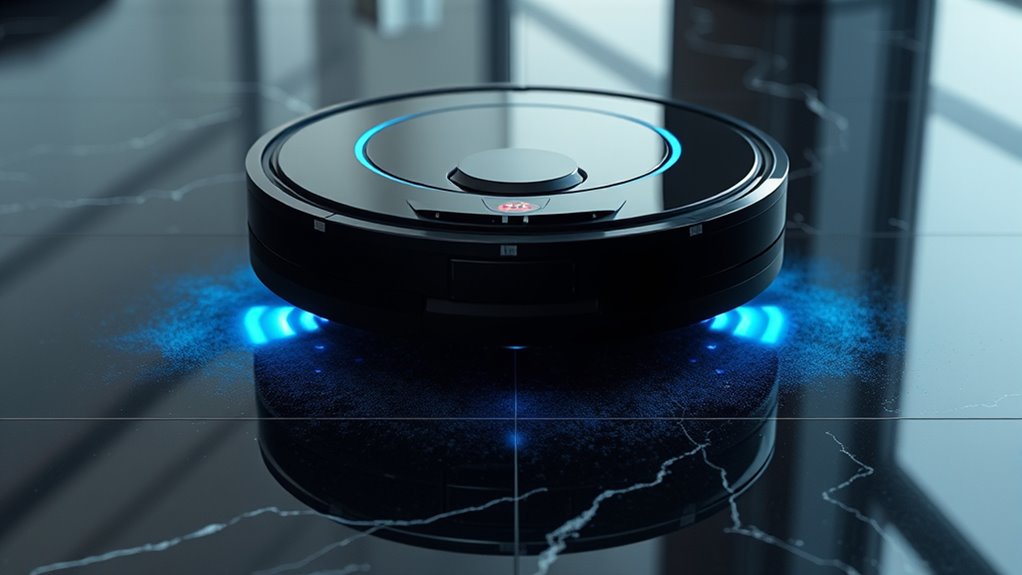To prevent cliff and wall errors on dark floors, regularly clean your robot vacuum’s sensors with a soft, lint-free cloth or a cotton swab dipped lightly in alcohol. Turn off the device before cleaning, and avoid harsh chemicals or spraying liquids directly. Gently wipe the front bumper, cliff, and side sensors to remove dust, hair, and smudges that can impair detection. Consistent maintenance guarantees smoother navigation—you’ll discover more tips if you continue exploring.
Key Takeaways
- Regularly turn off the robot and gently wipe sensors with a soft, lint-free cloth to remove dust and debris.
- Use a slightly damp cloth or isopropyl alcohol for stubborn dirt, avoiding excessive moisture to prevent damage.
- Focus on cleaning front bumper, cliff, and side sensors weekly or more frequently on dark floors.
- Use a soft brush or cotton swab dipped in alcohol to clean sensor crevices and hard-to-reach areas carefully.
- Ensure sensors are dry before powering on the device to maintain accurate obstacle detection and prevent errors.

Have you ever noticed your sensor struggling to detect dark floors accurately? It can be frustrating when your robot vacuum or cleaner keeps misjudging obstacles or edges, especially on darker surfaces. This common issue often stems from dirty sensors or dust buildup that confuses the device’s ability to distinguish between the floor and obstacles. Over time, dust, hair, or smudges accumulate on the sensors, impairing their function. Dark floors are particularly challenging because they absorb more light, making it harder for sensors to interpret the environment correctly. When sensors are dirty, the vacuum might think a wall or cliff is present, causing it to change direction abruptly or stop altogether. These errors not only hinder cleaning efficiency but can also cause unnecessary wear on your device.
To prevent these mishaps, regular sensor cleaning is crucial. Start by turning off your robot vacuum and gently removing it from the charging dock. Use a soft, lint-free cloth or a microfiber cloth to wipe the sensors carefully. If dust or grime persists, slightly dampen the cloth with water or use a small amount of isopropyl alcohol. Avoid harsh chemicals or abrasive materials that could scratch or damage the sensors. Pay close attention to the front bumper sensors, cliff sensors, and side sensors, as these are most involved in obstacle detection and navigation. It’s best to clean these areas weekly or more often if you notice erratic behavior or if the device seems to struggle with dark floors regularly. Additionally, sensor calibration can help improve detection accuracy and reduce errors over time.
When cleaning, be gentle—pressing too hard can damage delicate sensor components. Use a soft brush or a cotton swab dipped lightly in alcohol to remove stubborn dirt from tiny crevices. Make sure not to spray or pour liquid directly onto the sensors, as moisture can cause further problems. After cleaning, allow the sensors to dry completely before powering the device back on. A quick wipe-down can considerably improve sensor performance and reduce false cliff or wall errors. Remember, the key is consistency; regular maintenance ensures your vacuum can better interpret its environment, especially on dark surfaces where misreads are more likely.
Frequently Asked Questions
Can Sensor Cleaning Damage Dark Floor Surfaces?
Cleaning your sensor won’t damage dark floor surfaces if you use gentle methods. Avoid harsh chemicals or abrasive tools that could scratch or discolor the floor. Instead, use a soft cloth or microfiber towel with a mild cleaner to wipe the sensor area carefully. Regular, gentle cleaning helps maintain sensor accuracy without risking damage to your dark floors, ensuring your device functions smoothly and looks great.
How Often Should I Clean Sensors on Dark Floors?
You should clean your sensors on dark floors every one to two weeks, depending on usage and dust levels. Regular cleaning prevents dirt buildup that can cause cliff and wall errors. Use a soft cloth or compressed air to gently remove debris without damaging the sensors. If you notice the robot struggling to detect edges or walls, clean the sensors more frequently to maintain peak performance.
Are Specific Cleaning Agents Better for Dark Floor Sensors?
Did you know that using the right cleaning agents can extend sensor life by up to 30%? You should choose gentle, non-abrasive cleaners specifically designed for electronic sensors or dark floors. Avoid harsh chemicals like bleach or ammonia, as they can damage the sensor’s surface. Instead, opt for a soft cloth and a mild, alcohol-based cleaner to guarantee ideal performance and prevent errors caused by dirt buildup.
What Tools Are Safest for Cleaning Sensitive Sensors?
You should use soft, lint-free cloths or microfiber cloths to clean sensitive sensors safely. Dampen the cloth slightly with distilled water or isopropyl alcohol (at least 70%), avoiding excess liquid. Steer clear of harsh chemicals, abrasive pads, or paper towels, as they can damage the sensor surface. Gently wipe the sensor area in a circular motion, ensuring you don’t apply too much pressure to prevent any harm.
Can Sensor Cleaning Improve Overall Robot Navigation Accuracy?
Cleaning your sensors can dramatically boost your robot’s navigation accuracy, making it as precise as a laser beam. When dirt, dust, or smudges are removed, sensors detect obstacles and edges more reliably. Regular cleaning prevents errors like cliffs or wall misreads, ensuring smooth operation. Use gentle, appropriate tools to avoid damage, and you’ll notice your robot maneuvering more confidently, efficiently, and safely—almost like it has a new set of perfect eyes.
Conclusion
Now that you know how to keep your sensors clean on dark floors, the next step could be the difference between flawless navigation and unexpected errors. Will your efforts be enough to prevent those cliff and wall mishaps? Keep your sensors spotless and stay alert—one small oversight might lead to surprising setbacks. The key is consistency. Are you ready to master this simple yet essential task and guarantee your device performs flawlessly every time?









